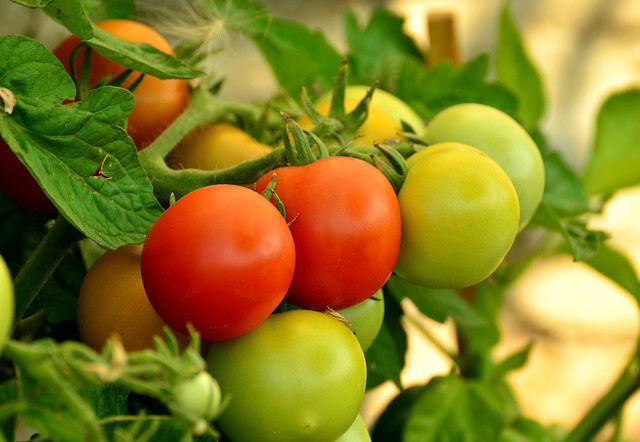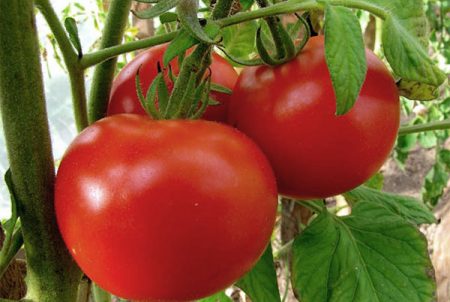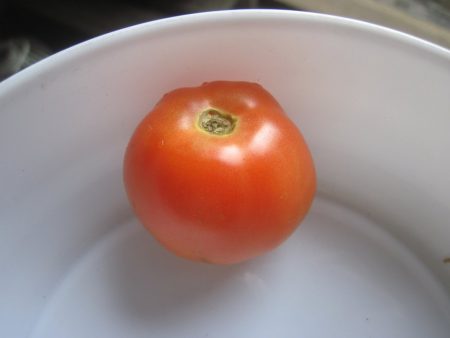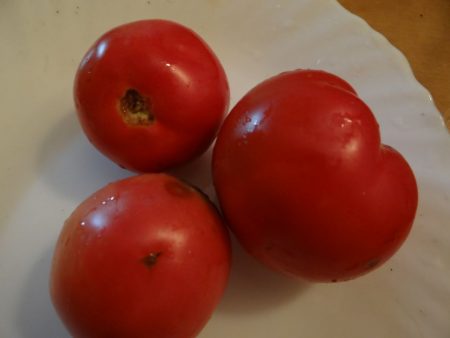 The sowing season is approaching, and now many gardeners are wondering what kind of tomatoes to plant. In recent years, a variety called "June" is gaining popularity.
The sowing season is approaching, and now many gardeners are wondering what kind of tomatoes to plant. In recent years, a variety called "June" is gaining popularity.
Probably, he liked many gardeners for their unpretentiousness and good productivity. Characteristics of the variety can be found in the article.
Content
Description
Belongs to early ripening varieties, ripens approximately 103-105 days after germination. The bush of the determinant type grows 40-50 centimeters in height. It is slightly branched, with large green leaves, has a simple inflorescence.
Fruits are flat-round, dense, not prone to cracking. Their weight can range from 100 to 140 grams, at the stage of maturity, the tomatoes turn red. They have excellent sweet and sour taste and aroma characteristic of tomatoes. They are distinguished by friendly ripening of fruits, which many summer residents really like. From one square meter you can get up to 7 kg of tomato. They are used as fresh food, in the form of salads, during processing they do not lose their taste. Suitable for making juice and sauces. The fruits can be pickled whole for the winter.
The variety "June" is listed in the state register of the Russian Federation as suitable for cultivation in open soil and a greenhouse. It can be planted throughout Russia and Ukraine, creating the necessary conditions for tomatoes, depending on climatic conditions.
Advantages
- Consistently high yields.
- Great taste of tomatoes.
- Universality of application.
- Unpretentious in leaving.
- Not susceptible to many diseases that are common among nightshade crops.
disadvantages - not seen
Diseases
This variety has natural immunity to such a disease as verticulosis, and due to its early ripening, the bushes simply do not have time to get Fitoftora.
Sowing preparation
Before planting, the seeds are first tested for germination, for this they are dipped in 5% saline. Seeds unsuitable for planting emerge, those that remain at the bottom are removed and dried. To grow stronger seedlings, they need to be tempered for 10 days, do it as follows: put in the refrigerator at night, and stored in the heat during the day. On the day of sowing for 30 minutes, the seed is soaked in "immunocytophyte", after 3 hours put in "Epin-extra."
The soil is also prepared in advance, during the winter it is then taken out into the cold, then it is brought into heat. Before planting in the soil, you can add a little wood ash.
Growing seedlings
Prepared seeds are sown to a depth of 1 centimeter, then watered and covered, for example, with cellophane. For biting sprouts, the optimum temperature is 23-25 degrees. After emergence on the surface of the earth, the shelter is removed, and the box with seedlings is placed in a bright place, the window sill is perfect, the room temperature can be reduced by several degrees. In the evening, young seedlings are highlighted, since daylight hours should be at least 15 hours.
After about two weeks, the seedlings will release a couple of real leaves, which means that the plants can already be dived into separate containers. Before transplanting, the seedlings undergo a hardening procedure, it is first taken out to fresh air for several minutes, gradually the time spent on the street is increased.
Transplanting into soil and care
Seedlings are planted on beds, as soon as the weather normalizes, the ground should warm up a bit. Since the autumn, the soil has been fertilized with manure and compost, thus providing bushes with nutrients for the entire season. In order to get an early crop, plants are transplanted into the ground when the flowering phase begins.
The recommended planting pattern is 70 to 30, that is, more than 6-7 plants should not be placed on one square meter. As you know, the bushes begin to bear fruit only after the root system has formed, so you need to regularly spud the bushes and loosen the aisles so that enough oxygen flows to the roots.
Water the tomatoes at least twice a week, pouring water preferably under the root, without falling on the leaves.
During the period of abundant flowering, you can treat the bushes with a stimulant that helps to form the ovaries. The June variety does not require garter and removal of stepsons, but nevertheless, some gardeners advise forming a bush of 4 stems. You can fertilize with organic fertilizers, but there is no particular need for this, for this variety there are enough nutrients that are contained in the soil.
Conclusions
“June” is quite unpretentious in leaving, so even beginners can grow it, you can plant bushes in the country and look after tomatoes on weekends. Harvest stable and early, which is a huge plus, who does not like fresh homemade tomatoes in early summer?
Reviews
Christina 30 years
Last year, we moved into a house with a small plot. I decided to try my hand at farming, I chose vegetables that can be grown in the garden, since the greenhouse has not yet been set up, with relocation, and so long as there is enough trouble. Opted for the variety "June", as it does not need daily care, and even early. She planted seeds in early March, in May she had already planted them on the garden bed, though they fertilized and dug up the soil in the spring, and not in the autumn, as recommended. Tomatoes ripened already in the twenties of June, the harvest is good, and there was enough food for conservation. I was satisfied with the variety, I plan to plant more next season.
Valery 65 years old
I’ve been growing tomatoes in my garden for twenty years, I’ve tried many varieties, I liked some more, some even disappointed. I want to write about the tomato variety “June”, it has been holding an honorable place on my site for several years. I like the fact that the bushes do not need to be constantly fertilized and remove stepsons. And their tomatoes already in June, they have a great taste, will appeal to all lovers of sweet and sour varieties. I sow seeds for seedlings in late February, early March, planted in April, if the weather has not improved a bit later, I use portable shelter, it helps me a lot. Harvest a good tomato for the early ones, taking into account that we cover them a little for the winter, we use later varieties for preservation.




 Low-growing tomatoes, without pinching: 5 of the most delicious varieties
Low-growing tomatoes, without pinching: 5 of the most delicious varieties Why tomato seedlings grow poorly
Why tomato seedlings grow poorly We grow a tomato in a shell
We grow a tomato in a shell Growing tomatoes without watering according to the method of Kazarin
Growing tomatoes without watering according to the method of Kazarin